Central African Republic
If you search for writing, videos or really any information on cooking in Central African Republic (CAR), you will quickly note that it barely exists. What does exist instead is mostly bad news – I mean, try to find a headline about Central African Republic that doesn’t have the words “killed” or “dead” in it. People there have been suffering for a long time, first under colonial rule and now while Christian and Muslim militias have been locked in a seemingly endless battle for control of the government. The weapon of late, for reasons of both convenience and probably effect, has often been the machete. More than half of the country’s population is starving, with little relief in sight.
In the midst of my research, this hit me in a way, or maybe in a moment, that I didn’t expect – on top of all of the advantages I already have as a straight, white, American male, just by virtue of living in a developed country I also enjoy the privilege of having time to think about food. What with living in a constant warzone and in abject poverty, there is a reason that time is apparently not spent writing cookbooks or making Youtube videos about food in CAR – such time, in and of itself, is a luxury. Food is enjoyed and appreciated there, of course; but when most of life is largely spent struggling to survive, agonizing over the merits of peanut oil over sesame or palm oil becomes a vulgar and vain act. The very fact that I have the time, resources and peace to work on this blog is an example (among many others, endless others) of the ridiculous and unearned ease of my life.
Another disheartening aspect of researching African cuisine in general is the relative lack of amplified African voices on the subject. This is a problem that one finds in every area of global cuisine, but in Africa’s case it is usually compounded by the arrogance and disdain of those who have attempted to speak for it, e.g. in place of it. I looked for months, read every website I could find in both English and French, and worked WorldCat until the computer started beading with sweat. What I found was deeply disappointing.
One of very few books addressing the cuisine of Central Africa, La cuisine au pays du soleil, is emblematic of the aforementioned colonialist attitude. It was produced by a publishing house based in Luxembourg called Éditions Saint-Paul in 1970 – FORTY-SEVEN YEARS AGO, GUYS – and like most Western-written, pre-millennial “ethnic” cookbooks that attempt to sum up an entire continent’s diverse cuisine in 300 pages, it is a complete disaster.
On the upside, I got to visit the NYU Bobst Library’s Special Collections for this very rare book, which was a real treat for a dork like me. I got to sit at a big table all by myself, and an assistant brought the book to me on a big foam platform. It had heavy ropes to hold the pages down, which minimized the amount of skin oils that my fingers would pass onto the paper. Unfortunately, the physical act of receiving and examining the book was the best part of this experience.
Overall, about 85% of this book is unattributed, miscellaneous “African” recipes, and about 30% of those recipes are, inexplicably, traditional French dishes like boeuf bourguignon. The majority of the dishes presented in this book are African only in the vaguest sense, distressingly overlaid with the structures, techniques and jargon of French nouvelle cuisine. While written by presumably well-intending missionaries, this cookbook – one of the scant few in Western languages to even address cookery from the center of Africa, I remind you – is nevertheless another reflection of the grand formalist exercise of codifying “other” cuisines from within the context of the colonizer’s own gastronomy. There appears to have been almost no effort expended to understand this cuisine in its own context.
I found a better version of my own thoughts on this topic in a piece written by Dr. Agnes Czajka of York University in Canada, entitled “The African Orient – Edward Said’s Orientalism and ‘Western’ Constructions of Africa.” For those unfamiliar, Edward Said literally wrote the book on Orientalism, which is defined as a generally patronizing and condescending attitude that the West demonstrates toward non-Western or subaltern cultures. In any case, Dr. Cjajka stated that Africa and Asia “have been the objects of the most reductionist, delusional and artificial discursive constructions, which continually permeate and constrain the manner in which the ‘West’ conceives of them.”
She continues, stating that “within an Orientalist paradigm… a knowledge possessed by the powerful outsider becomes the foundational and often undisputed knowledge that necessitates acceptance. While critical knowledge(s) and histories that challenge this Knowledge indeed exist, it is often difficult for them to compete with the power that buttresses the version perpetuated by the hegemon.” Further, “it reinforces the subject position of the [West], vis-a-vis the object status of the Orient, through the power of the former to name, classify and construct the latter.”
Many 19th-century explorers, writers, travelers and theorists spoke and wrote from a hegemonic position that asserted the fiction that “culture of any sort evad[ed] Africa, leaving it to its natural state of uncivilized barbarity… Nothing can be rescued, nothing revived, for there was never anything there, never anything to degenerate from.” I can admit to having had thoughts like these myself, at times, especially watching the acts of horror shown on the news – “how can this cycle ever be stopped?” The parts we are typically shown of Africa are hopeless, which is either an intentional act designed to maintain low expectations of the continent and preserve the dominance of the West, or an unintentional act driven by fear, hate, pessimism or worse. Images of Africans as everyday people – not as bloodied, starving bodies or wild-eyed warlords – are extremely scarce in Western media, and if you are not actively seeking them out, you are liable to never see them at all.
Anyway, back to that disastrous cookbook – the one salvageable Central African recipe in the text was a reflection of one I had found online, and even then was almost identical in its ingredient list and methodology. Maybe I had found the source document for all the versions of Central African “beef with okra” that are online? I’ll never know for sure, but I think so, as it predates all of the other recipes I found in my months of searching. Central African Republic’s cuisine is heavily based on native greens, bushmeat and bugs, which are not only impossible to get in the U.S., but also probably impossible to get anywhere BUT in central Africa. So, in this case, we absolutely have to keep it simple.

So yeah, beef with okra, or “boeuf aux gombos” – that’s our first dish. This stew and the one that comes after it are representative of the entire region of Central Africa, because they use basically what is grown there – greens, peanuts, onions, okra, chilies and tomatoes. (Note, as well, how almost all of these ingredients are not native to Africa, having been introduced by colonizers and slave-traders…) Meat is a luxury not shared by all Central Africans, although if one uses meat, beef, as I have read in several places, is “a must.” You basically just sear some meat and then some onions:
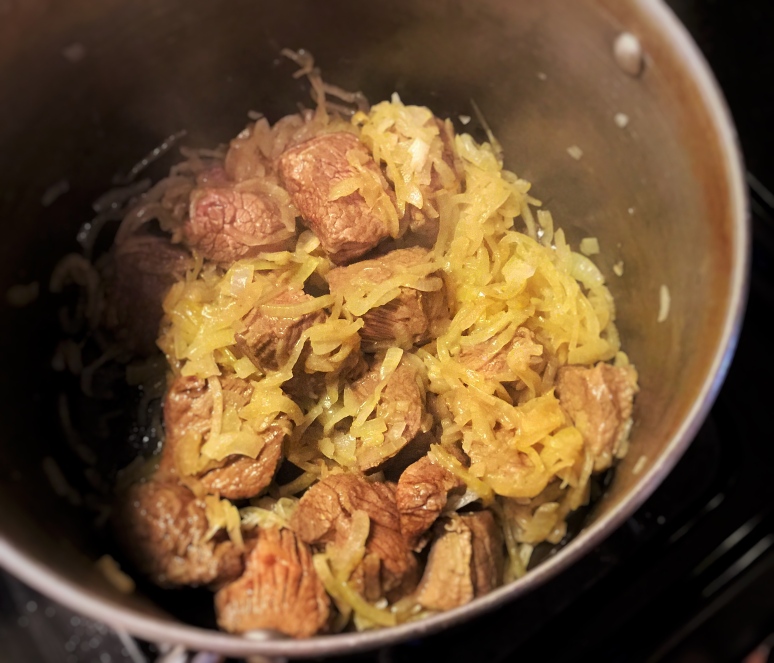
Add some aromatics and scotch bonnet chili paste (known as piment), and let the whole thing hang out and tenderize, hot-tub style. Then, once the meat is tenderized to your liking, you add some okra and stew a little longer. Boom. Done.
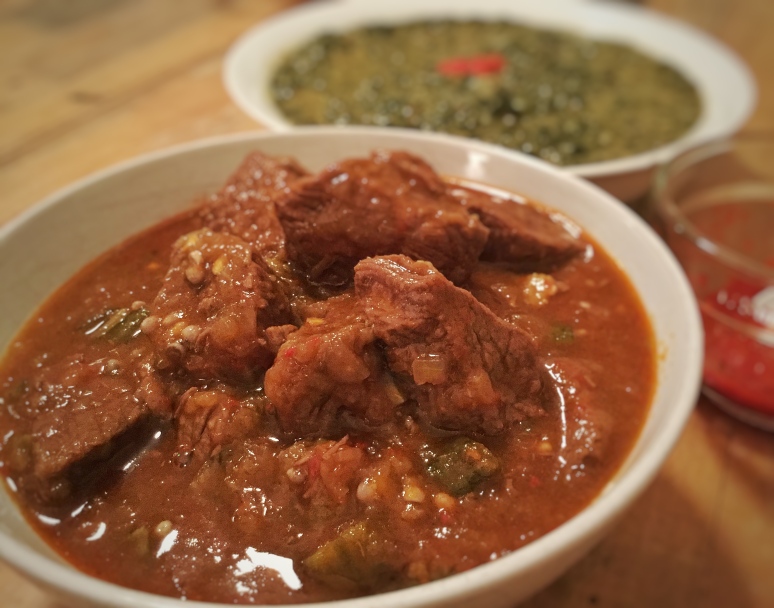
Can I tell you something? I have cooked some outrageously complicated dishes during the last few years of this blog – some were good, some were not. But this simple, honest stew? It was, without question, one of the most delicious things I have ever cooked. So simple and so tasty – rich, spicy, tongue-coating and tender. I couldn’t stop eating it. Please make it, seriously, you’ll love it.
I’m tempted to say the same thing about the next stew, which we’re calling “Spinach Stew” – despite being so simple, it is a rich, satisfying flavor blast, especially when taken with a bite of cassava fufu. Just take some spinach and chop it up really fine, or even grind it if you have a wet-grinder.
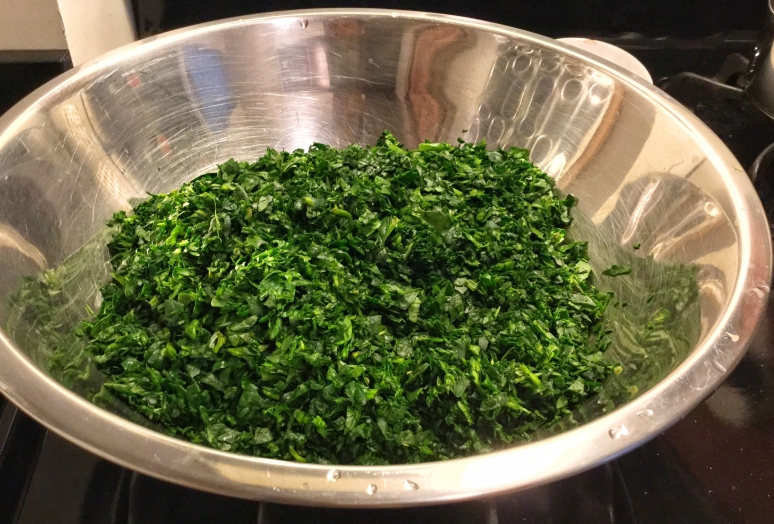
Then you just fry up some onion, then some tomato, then the spinach goes in along with more piment and natural peanut butter.
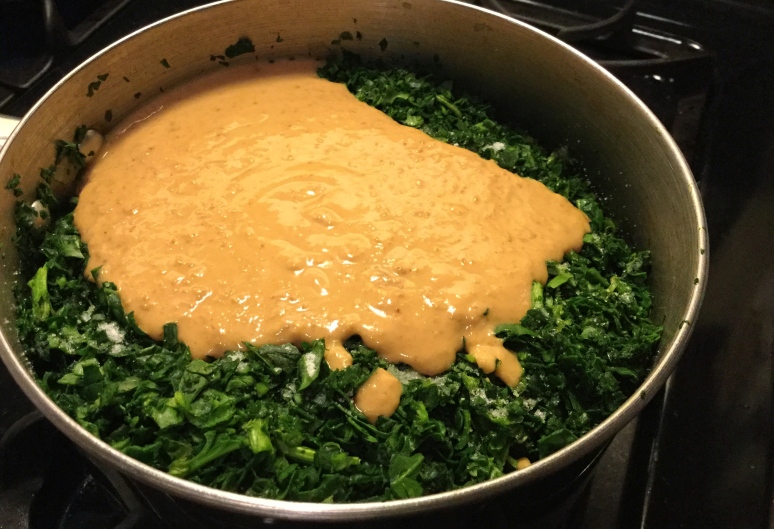
Twenty minutes later you are chowing down and realizing why folk wisdom says you are not supposed to chew your fufu – why take longer to get this into your gut than absolutely necessary? The flavors of peanut and spinach are born to be wed, and the savory glutamates in the tomatoes make a great maid-of-honor. The piment is the poorly-behaved ring-bearer, I guess.
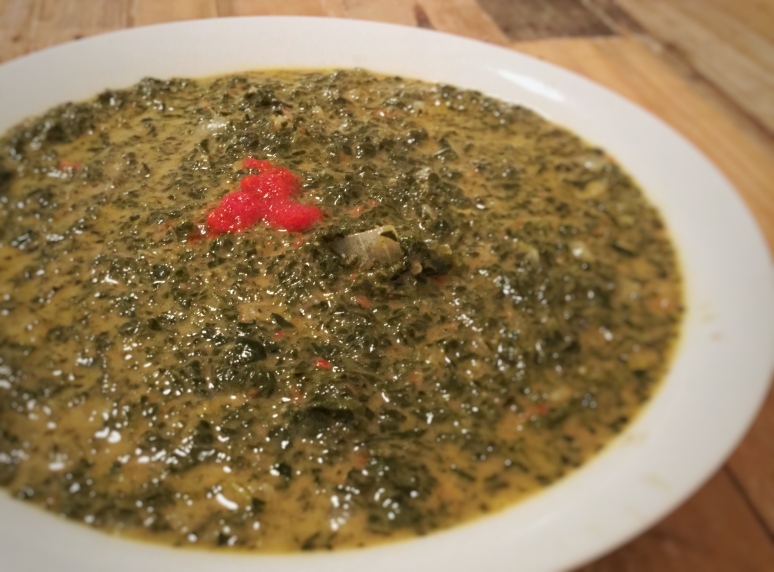
That little extra dab of piment was enough for me, but some people may want way more. In any case, you make it by just pureeing or mashing a scotch bonnet into paste, like so:
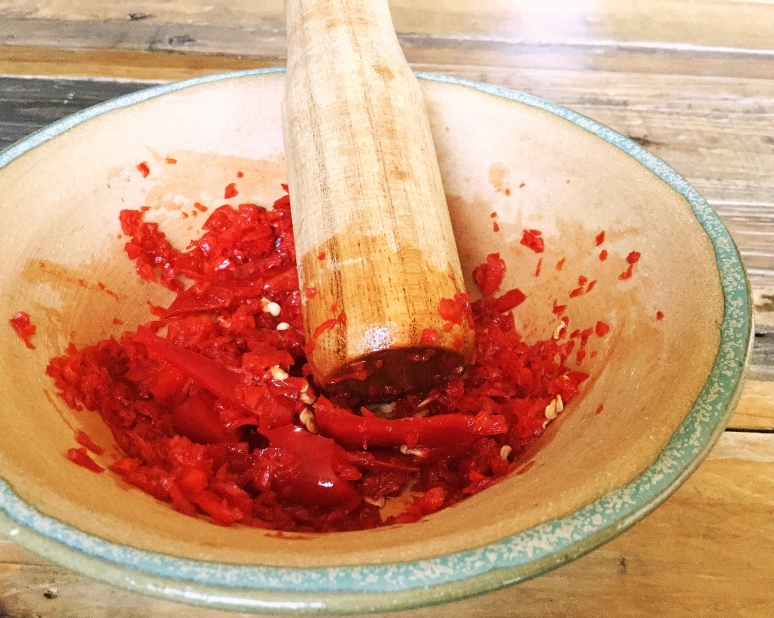
Keep going until it’s pretty liquid – you can add salt and splash of water if you need more grit or lubrication. Careful! It’s hot.
Finally, we need to make our fufu, or boule or kàm as it’s called in Central African Republic. La boule is pretty much the main component of a Central African meal, according to this kind of intense book I found at the Schomberg Center called Cuisine et nourriture chez les Gbaya de Centrafrique. The boule is never eaten alone, so you need something to go with it (stews, nut or seed pastes, piment etc.), plus it is also the utensil with which one consumes non-boule items.

I’ve made fufu a couple of different ways by now, but this time I opted to go for the easy way – fufu flour. It’s harder than it seems, though – I poured it into the water too fast, and it clumped a bit. Since it sets so quickly, there is no time to whisk out the lumps, so I will really have to learn some patience before the next time I try this.
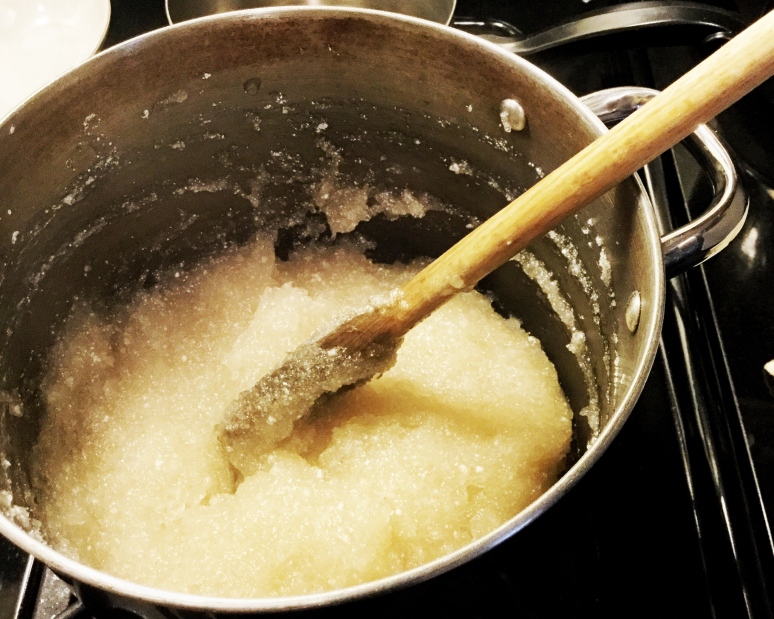
Regardless, I poured this starchy blob into a bowl that had some plastic wrap lining it, then closed up the wrap and let it cool for a little bit – that sets it into a boule-like shape, after which it can be turned out on a plate and unwrapped, like this:
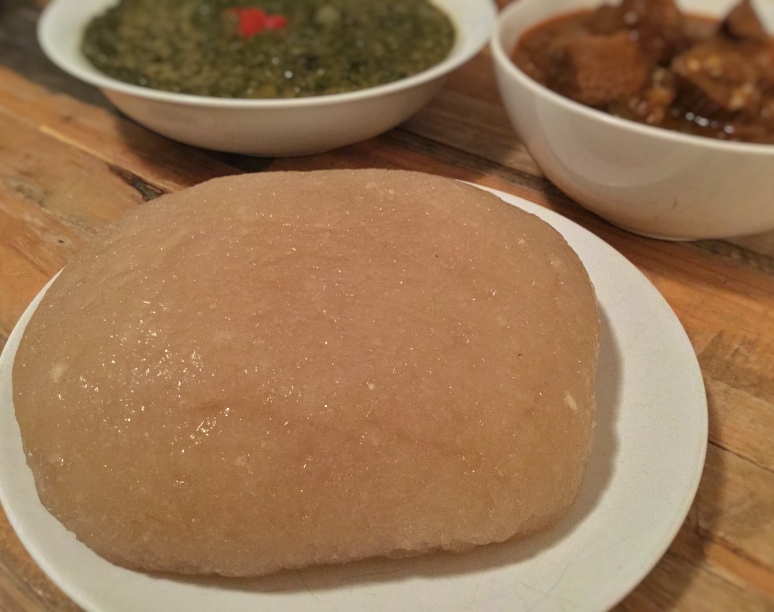
Then you just take a chunk with your fingers, form a little pad, and then scoop some stew onto it and, quickly and carefully, into your mouth:
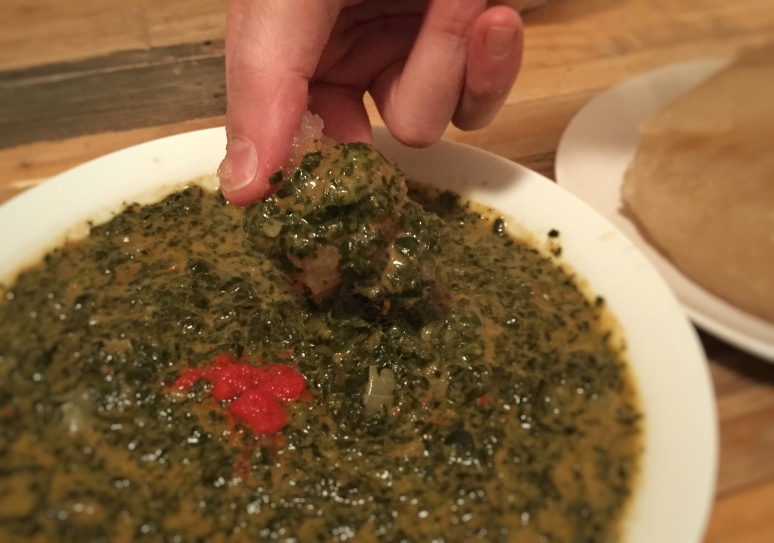
You might be thinking, “dude, that’s not much stew you’re picking up there – you’re going to end up eating a lot of that fufu.” Well, you’re right – the boule is a quick-burning, highly-processed carbohydrate, full of calories and very filling, and also not very expensive. The stews are just there to make the fufu a little more interesting, since on its own it sort of just tastes like communion wafers. As that book on the Gbaya people mentioned above, the boule is the base of the meal.
So, are these “famous” recipes from this country? Well, yes and no – dishes like these are found all over Central Africa and don’t necessarily have a fixed name, precisely because they are so ubiquitous and so malleable. Instead, they are named for what is in them at any particular time – like “vegetable soup” or “garden salad.” Dishes like these are simply what people eat – nothing more, and nothing less. They are relatively immune to fetishization due to their mutability and dependence on seasonality (and availability). The 2016 Global Hunger Index just named Central African Republic the most impoverished country in the world, with over 76% of its inhabitants without sufficient nutrition – you can see, then, how following a recipe could often be a useless and impossible expectation. One cooks what one has, in a way that makes sense within the culture – and in Central Africa, that often means boiling.
Central African Republic, you have reminded me that simple dishes often taste the best. Your food speaks for itself, and thankfully is much louder than those voices that have tried to speak over it. Hopefully I have not made things any harder for you – I tried my best!
Now you go:
Boeuf aux gombos
1 ¼ lbs. stew beef, cut into 2-inch pieces
3 tablespoons peanut oil
2 yellow onions, thinly sliced
2 tbsp tomato paste
6 okra, washed and cut into 1-inch slices
salt
1 Scotch bonnet chili (capsicum chinense, anyway), seeded and pureed
Heat the oil in a Dutch oven and sear the meat over medium-high heat. When meat is browned, add the sliced onions and cook until also slightly browned. Add the tomato paste and some scotch bonnet paste (aka piment) to taste (or dried chili powder, if you prefer), salt lightly and cover with water.
Simmer, covered, over low heat for 2 hours.
Uncover, add the okra and simmer again, uncovered, for 30 minutes. Add water 1/4 cup at a time if the stew begins to dry out.
Serve with cassava fufu (aka “la boule”).
Spinach Stew
2 onions, finely chopped
2 tbsp palm oil
2 tomatoes, peeled and sliced
1 ½ lbs fresh spinach, very finely chopped
4 tbsp natural peanut butter
1 tsp salt
Piment (Scotch bonnet puree) to taste
Heat oil over medium and saute onions until soft.
Add the tomatoes, and after 1 minute add the spinach, salt and piment. Cover with a tight-fitting lid, reduce to a simmer and cook for 5-10 minutes, until the spinach is wilted.
Mix the peanut butter with ½ cup of warm water and form a smooth paste. Add this to the pot and continue cooking for 15 minutes, stirring frequently. Add water 1/4 cup at a time if the stew begins to dry out.
Serve on white rice or with fufu (aka “la boule”).
Cassava fufu
2 cup yucca flour (fufu flour)
4 cups water
Bring the water to a boil, then reduce heat and SLOWLY, SLOWLY GOD DAMMIT stir in the fufu flour. It should readily congeal into a lump – stir as long as you can until it is stiff enough for the spoon to stand up in it by itself, then removes from heat.
Transfer to a plastic wrap-lined bowl, then seal tightly in the wrap. Allow to cool for 5-10 minutes, then serve on a plate alongside stews and condiments.
Sources:
Roulon-Doko, Paulette. Cuisine et nourriture chez les Gbaya de Centrafrique. Paris: L’Harmatton, 2001.
Soeurs missionnaires du Saint-Esprit. La cuisine au pays du soleil: 750 recettes recueillies en Afrique noir, a Madagascar et aux Antilles. Issy-les-Moulineaux, France: Editions Saint-Paul, c1971.
https://fr.wikipedia.org/wiki/Cuisine_centrafricaine
https://en.wikipedia.org/wiki/Economy_of_the_Central_African_Republic
https://fr.wikipedia.org/wiki/Cuisine_africaine
http://www.healthy-life.narod.ru/wor_ek40.htm
http://www.recettesafricaine.com/sauce-epinard-gombo.html
http://www.diakadi.com/afriquecentrale/pays/centrafrique/kanda.htm
http://www.journaldebangui.com/article.php?aid=313
http://beafrikatimo.over-blog.com/2016/03/centrafrique-bangui-cuisine.html
http://books.openedition.org/irdeditions/1641?lang=en
http://www.afrik-cuisine.com/recettes/ragout-de-boeuf-aux-epinards-et-a-l-arachide
http://www.petitfute.com/p111-republique-centrafricaine/guide-touristique/c46396-cuisine-locale.html
http://lafeedescoquelicots.superforum.fr/t396-recette-centrafricaine-kanda
http://www.afrik-cuisine.com/recettes/gombos-au-boeuf
http://www.cuisineafricaine.org/details_recettes.php?idRecette=756&&idFamilles=7-boeuf-aux-gombos
http://www.recettesafricaine.com/sauce-epinard-gombo.html
https://halshs.archives-ouvertes.fr/hal-00511970/document
http://www.worldtravelguide.net/central-african-republic/food-and-drink
[https://youtu.be/gcV0zFzIEPE]


Yay! Mark’s back! Great post!
I really enjoy your writing and totally understand where you are coming from about the privilege of being able to write about food. Thanks for the recipe. I might try it with antelope.
Thank you for reading!!
I am loving your blog! PLEASE CONTINUE.
Thank you Eva!!!!
Pingback: Central African Republic – Read around the world